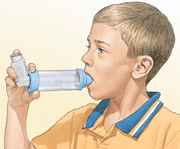For Parents: Medications to Control Your Child’s Asthma
Medications are often an important part of managing asthma. Ask your child’s healthcare provider about your child’s asthma medications. Find out how they work, how they’re taken, and what their possible side effects are. There are two types of asthma medications:
-
Long-term controller (maintenance) medications reduce inflammation of the airways. A child with asthma can have inflamed airways anytime, not just when he or she has symptoms. So controller medications are taken daily, even when the child feels well. This helps prevent asthma flare-ups.
-
Quick-relief (rescue) medications help stop an asthma flare-up that has already started.

For Long-Term Control of Inflammation
Using controllers daily has been proven to reduce the chance that a child will have to go to the emergency room or need to stay in the hospital. Most kids with asthma take long-term controller medication. Be aware that:
-
These medications don’t help improve breathing right away. Other medications are used for quick relief (see below). Your child won’t feel controllers working, but you’ll see the effects in time.
-
To do their job well, controller medications must be taken every day, in many cases twice a day.
Taking Long-Term Controller Medications Daily
Your child may be confused by having to take medication when he or she feels well. And remembering to take medication each day can be hard for anyone. You can help by being firm and consistent. Try these tips:
-
Develop a routine. Make taking long-term controllers part of getting ready for bed or getting ready for school.
-
Set up a reward system. For example, award a point for each day your child sticks to the schedule. Your child then earns rewards based on these points.
-
Make sure your child understands what long-term controllers do and don’t do.
-
Explain the role of these medications to any other caretakers. That way, the routine will be followed when your child is in someone else’s care.
-
Don’t make any medication changes without the approval of your child’s healthcare provider.
|
Controller Medications Your Child May Take
|
Medication
|
How It’s Taken
|
What It’s Used for
|
|
Inhaled corticosteroid
|
Inhaler or nebulizer
|
Controls airway inflammation. The first-choice controller medication for most kids with asthma.
|
|
Other anti-inflammatory
|
Inhaler or pills
|
Helps control airway inflammation. Used for mild asthma or along with inhaled corticosteroids.
|
|
Long-acting bronchodilator
|
Inhaler
|
Keeps muscles around the airways from becoming tight. Used only in combination with inhaled corticosteroids.
|
|
For Quick Relief of Flare-Ups
Even when asthma appears to be controlled, flare-ups may still happen. Knowing how to manage flare-ups is another key to asthma control. To do this, learn to recognize your child’s symptoms and to act quickly. That way, when your child has a flare-up, you can stop it before it gets serious. Your child’s action plan tells you exactly what symptoms signal a flare-up, and what to do. The action plan may include:
-
Using quick-relief (“rescue”) medication. This eases your child’s breathing right away. But keep in mind that quick-relief medications don’t do anything to control the cause of the flare-up.
-
Continuing or increasing controller medication. This treats airway inflammation, which is the underlying cause of the flare-up.
-
For severe flare-ups, taking an oral corticosteroid (“burst” medication). This medication is taken for a short time, often just a few days. It relieves severe inflammation.
|
Quick-Relief Medications Your Child May Take
|
Medication
|
How It’s Taken
|
What It’s Used for
|
|
Short-acting bronchodilator
|
Inhaler or nebulizer
|
Gives quick relief by relaxing the muscles around the airways.
|
|
Oral corticosteroid
|
Pills or liquid
|
Taken for severe asthma flare-ups. Reduces swelling and mucus in airways.
|
|
© 2000-2024 The StayWell Company, LLC. All rights reserved. This information is not intended as a substitute for professional medical care. Always follow your healthcare professional's instructions.